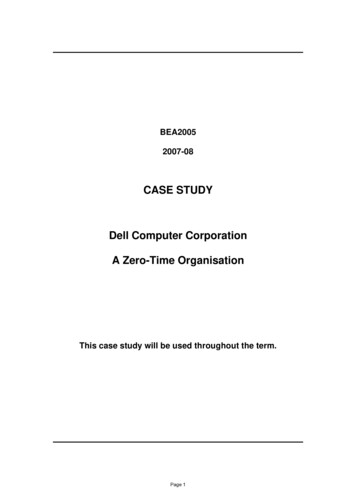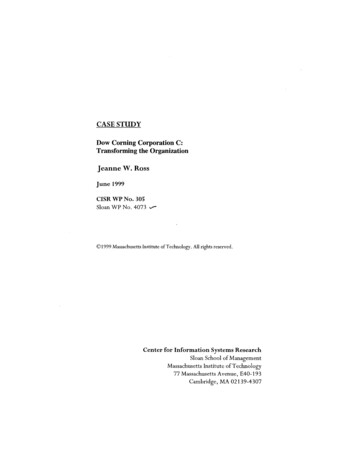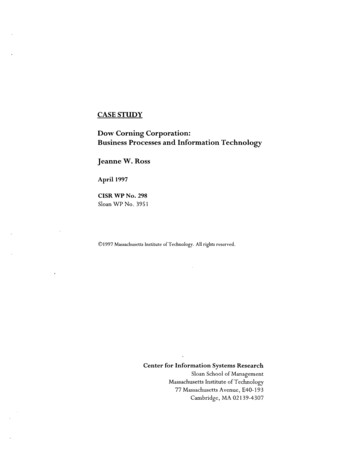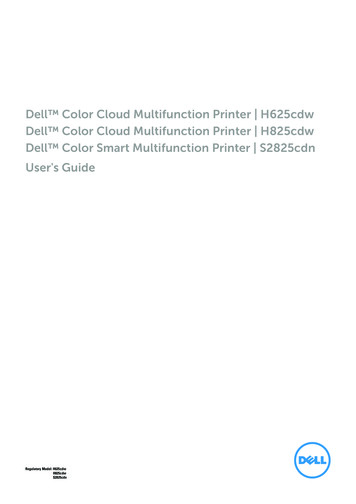
Transcription
BEA20052007-08CASE STUDYDell Computer CorporationA Zero-Time OrganisationThis case study will be used throughout the term.Page 1
Dell Computer Corporation:A Zero-Time OrganizationDeep in the heart of Texas lies a Fortune 500 company who exemplifies many of the principlesof a Zero Time organization. Dell Computer Corporation has seen extraordinarily growth: a58% revenue increase and an 82% profit increase in 1997, an equally extraordinary shortperiod of time. Sales rose to 12.3 billion in 1997, profits to 944 million in 1997, and the stocksplit for the sixth time in 1998. Much of this success is due to management principles and avision that we describe here. First we provide some background information on the company,and we describe the management principals and philosophies we think make Dell a success.Finally, we describe Dell using the lens of a Zero Time organization.Company BackgroundMany know the story of Michael Dell, his college-based business of building personalcomputers with available parts, and his build to order strategy. Founded in 1984 as PC’sLimited, the name was officially changed worldwide to Dell Computer Corporation when thefirst stock offering took place, in June 1988. Other key turning points, according to MichaelDell, were in 1986, when Dell first went outside the US to Europe and hit 50 million in sales;1989, when the company when from last to first place in their industry on the management oftheir inventory; and 1993 when the concept of segmenting took shape and allowed themanagement to regain control of customers.At the core of Dell’s business was the build-to-order strategy. Customers ordered PCsdirectly, and their order was routed through a credit check, then directly to the manufacturingfloor. The order was then built, tested, and shipped to the customer, who received it 5-7 daysafter placing their order.This strategy afforded Dell some impressive results. First, Dell eliminated middlemen-theresellers, who were part of the traditional distribution model. As such, Dell not only passed thesavings to the customers in the form of lower costs, but was also able to understand customerneeds first hand and adapt to market changes faster than competitors. Second, Dell builtcomputers directly for customers, not for inventory. This meant that the company did not wasteresources building systems that may not reach a customer, need staffing positions to moveinventory around the world, or spend time managing and tracking inventory, and reworkingsystems that become obsolete before purchased. Third, Dell Computer practiced just-in-timemanufacturing, where trucks with vendor parts pulled up to one side of the plant, and unloadedPage 2
directly into bins used for building customer orders. These parts did not become the property ofDell Computer until they were unloaded, which took place as frequently as every few hours.Fourth, information systems tied together the entire company, routing orders to the next step inthe business process and eliminating waits, backlogs, and losses that a less automated systemmay experience. Michael Dell explained,In this business, it is not about how much inventory you have, but about how fastit’s moving through the cycle. I don’t want a warehouse of stuff, because itbecomes obsolete so quickly. With our model, we start with the customer whoseorder pulls inventory through the channel. That results in our ability to deliver adesktop computer in 3 days which is configured exactly as the customer wants.That provides a great deal of value.In 1998, Dell Computer employed 16,000 employees in central Texas, its largest workforce,and was in the process of expanding their European facility, in Limerick, Ireland, to 4500employees. There were five plants: three in Texas, one in Ireland, one in Maylasia. A sixthplant was planned for China, and a seventh was planned for Brazil.Customers were initially divided into three categories: Large businesses, Small to mediumbusinesses, and personal consumers. Each group was supported in a manner consistent withtheir requirements. Large businesses had dedicated sales people who managed the orders.Small and medium businesses shared sales staff who insured that the needs of thesebusinesses were met. Individual customers interested in Dell’s products were served by eithertelephone-based inside sales people, or later by the sales system on the Internet. Underlyingall customer accounts was the famous Dell Direct distribution strategy. The inside sales forcetook phone calls from a toll-free phone number from customers seeking information about theproducts and placing orders. These sales people sat at a computer at one of the Dell officesand serviced customers as they called in. The entry of an order by the inside sales groupinitiated the entire build to order process. Customers with corporate accounts could order fromthese sales people, or they could work with the dedicated sales teams for the corporateaccount. Each large account had field people in charge of the relationship with the client, anddedicated team members in Austin, Texas to service the account. But the ability to call directlyto Dell, order a computer, and have it arrive a week later became the cornerstone of thebusiness.In 1996, Dell expanded their direct order model to the Internet, and their success in this mediumquickly became legendary. Scott Eckert, Director of Dell On-Line, began as Michael Dell’sExecutive Assistant in 1995. In 1996 when Dell decided to launch an on-line sales program,Eckert took over the project. In the first quarter of 1997, the on-line business did 1million perday in sales. In the second quarter, they did 2 million per day, and the success continued. Bythe end of the first quarter of 1998, Dell logged 5 million in sales per day, by the end of thethird quarter it was up to 10 million per day in sales over this channel, and the rate of growthwas expected to continue. In addition, the web site had grown in functionality. In 1994, it was asimple technical support tool for disseminating tips and bug-fixes to internal and externalcustomers. In addition, Dell conducted customer surveys. In mid-1996, Eckert was put in chargeof using the Internet for a “yet to be determined” online business. The first application was anorder status system, where customers could track their orders through the Dell process.Page 3
By fall 1996, the configurator system was ported to the Internet, and electronic commercebegan. The configurator assists customers in designing the exact product they need, and inpricing it out. Once this system was available to customers, the revenue took off. Eckertexplained,Using the Internet, we were able to offer our corporate customers specialservices like our Premier Page. This was a custom web site designed anddedicated to the individual corporate account. It included sales and technicalinformation. One part of this service was a set of standard configurations for thecustomer based on those approved by their information technology people.Another part was technical support custom designed for the systems we knowthe customer has. We even linked the premier page to the technical supportpages in our internal customer support system. A third part of this page hadreporting tools like purchase history and service history so that the customercould keep track of their Dell activity. And we included some marketinginformation such as the account team contact information. We had built over8000 of these pages, and each one was different. Some had the orders godirectly to us, while others had the orders pass through their internal groups forapproval. We had the ability to offer this level of customization in our sales andcustomer service using the Internet.Dell Computers was best known for its pioneering use of the direct marketing channel for sellingand distributing personal computer systems. Its well-known strategy of manufacturing a systemfor a customer, or build to order, provided Dell with a cascading series of advantages over itscompetition including low inventory costs, no dealer costs, and current technology in everysystem manufactured. Conventional wisdom said that it was necessary to have inventories ofsystems in order to provide customers with many choices, and it was necessary to have thosesystems sold through dealers who could explain the complexities of the systems and givecustomers a chance to “kick the tires.” Instead, Dell gave the customer a chance to pickwhatever features he or she wanted from those available. In addition, Dell manufacturedsystems only after they were ordered by a customer, which conventional wisdom would say waseither too costly or took too long. But Dell was able to guarantee delivery within five to sevendays of order. Finally, Dell saw that personal computers were becoming a commodity andrealized that sales people would not be needed to explain the systems in the conventional,physical way.The result was a win/win situation for both Dell and its customers. Factory inventory was atmost three days, supported by tight alliances with suppliers who deliver smaller loads, but morefrequently than traditional manufacturing systems. Downstream inventory was zero since thesystems were directly shipped to customers. No one in the “stream” was sitting with more than 7days of inventory, whereas traditional supply chains held up to 60 days of inventory of parts and30 days of inventory of systems for dealers. Exhibit 1 summarizes the business model of Dell,as compared to a more traditional value chain model.Management PrinciplesThe Dell Direct Model, described in Exhibit 2, highlights how the build-to-order philosophywas central to the Dell management principles. The direct model was the mostPage 4
visible and important principle of Dell: it aligned all of Dell’s business units and people. Withinthe Dell organization, the direct model meant that everyone was a customer. For example, theIT organization had very few central staff. Almost all of the IT personnel reported directly tobusiness units. Similarly, Dell University was structured into different colleges each residing in abusiness units. In fact, Dell University’s budget did not come from corporate, it came from eachbusiness unit, and hence Dell University’s survival depended on the satisfaction of each of itscustomers. The philosophy of central planning with local implementation supported the directmodel principle. This philosophy enabled the organization to grow at its breathtaking ratebecause it provided the capability of build to order for all parts of the organization and allbusiness processes needed to run the corporation.In addition to the principals of build to order and direct marketing, Dell Computer managersspoke of a few key principles that were fundamental to their business. These included: Exchange inventory for informationVelocity, value and volumeConstant changeCriticality of coordinationExchange inventory for informationAt the heart of the successes at Dell was their strategy of exchanging inventory for information.This meant that instead of keeping inventory on hand at Dell, or on hand in a warehouse, or onhand at a retail outlet, Dell kept information about customer orders, needs, and forecasts.Manufacturing predicted what orders would come in, alerted suppliers of anticipated neededparts, and staffed up to meet demand. This gave Dell an advantage in the marketplace forseveral reasons. Information was easier to store than inventory. Information was easier tomove than inventory. Information was easier to discard than inventory. And information wasless expensive to have than inventory. Consequently Dell managers architected a way tominimize inventory, and in its place use information. This dovetailed with the build-to-orderphilosophy Michael Dell had used since he began his business, since both helped achieve theminimum inventory possible. As soon as demand forecasts changed, information about thatchange was sent out to the rest of the organization and shared. The closer Dell got to thisexchange of inventory for information, the closer they got to their vision of strategic advantagethrough cost and service.This advantage was also passed on to the suppliers. Eckert elaborated,The business was founded on the idea of getting the middleman out of thetransaction. The next step is to build Internet capabilities for our suppliers. Forexample, we can give suppliers like Intel a view of processors shipping out ofour factories on a very frequent basis. That is quite a bit different from what ourcompetitors can do, since they put finished systems in inventory first which aresold later by a reseller. Therefore they don’t have a direct view into what thecustomers are actually buying. As we refine our information we can reduceinventory levels and the cost for our suppliers will decrease.Page 5
Focus on velocity, volume and valueAs Dell exchanged inventory for information, they increased velocity, or the rate at which theirbusiness processes happen. Velocity was a critical focus for Dell management. In order tomanage the changing requirements of their customers and the changing technology critical totheir products, it was necessary to be able to quickly and effectively respond. This was termedvelocity at Dell. Michael Dell expressed this as a "time driven" culture, where the focus was onhow fast inventory is moving rather than on how much inventory there was.As velocity increased, the volume of business increased. Volumes were dependent on theamount of information Dell could obtain or access, store and process. The ultimate result of thiswas value to their customers, shareholders and employees. For example, the rate of theirinventory turns was multiples of their competitor, which translated directly into a steady andlarge volume of supplies from suppliers. In addition, Dell’s systems provided a view of customerdemand in real time. This gave Dell the opportunity to negotiate f
the Dell organization, the direct model meant that everyone was a customer. For example, the IT organization had very few central staff. Almost all of the IT personnel reported directly to business units. Similarly, Dell University was structured into different colleges each residing in a business units. In fact, Dell University’s budget did not come from corporate, it came from eachFile Size: 490KBPage Count: 25











